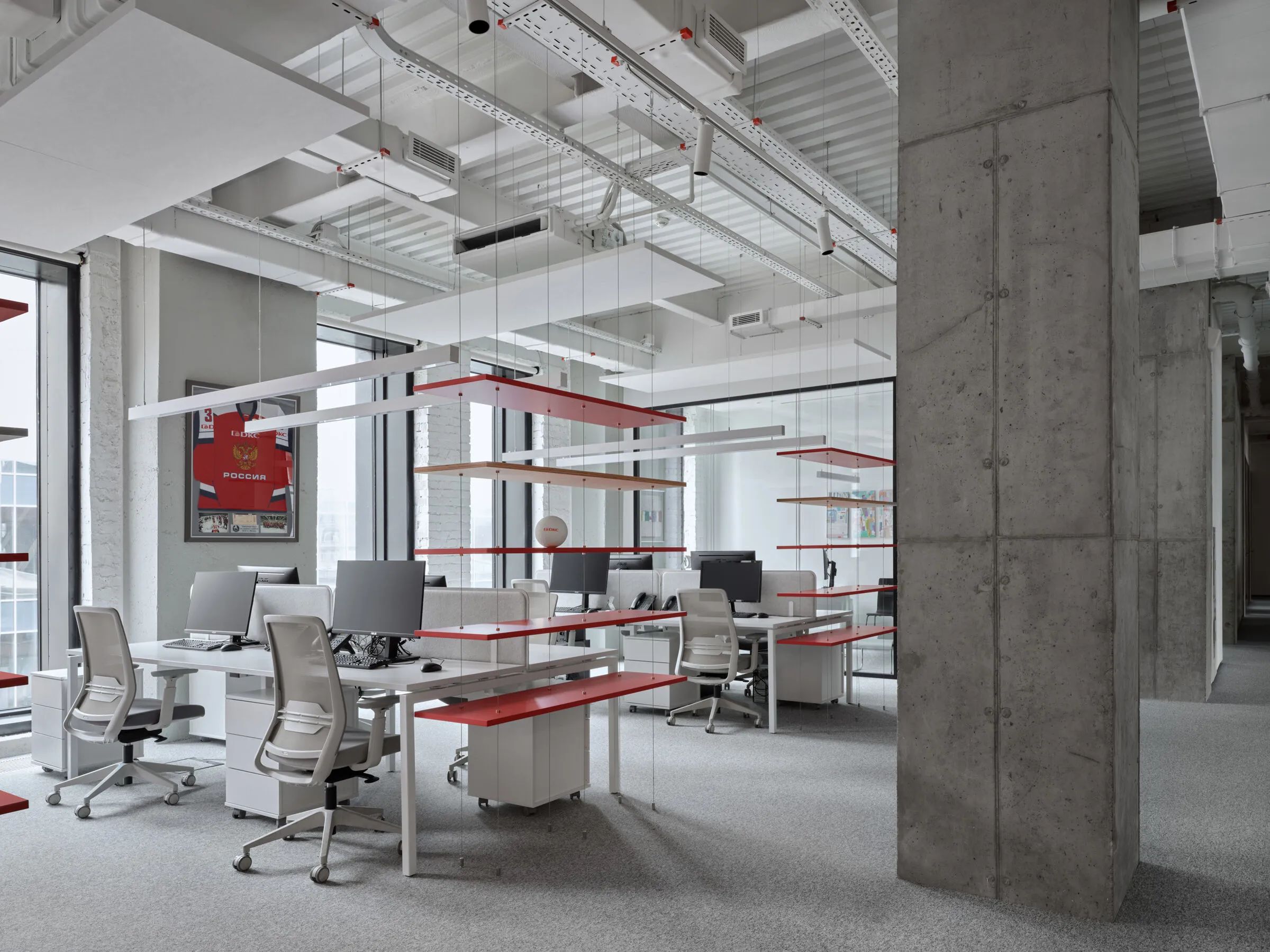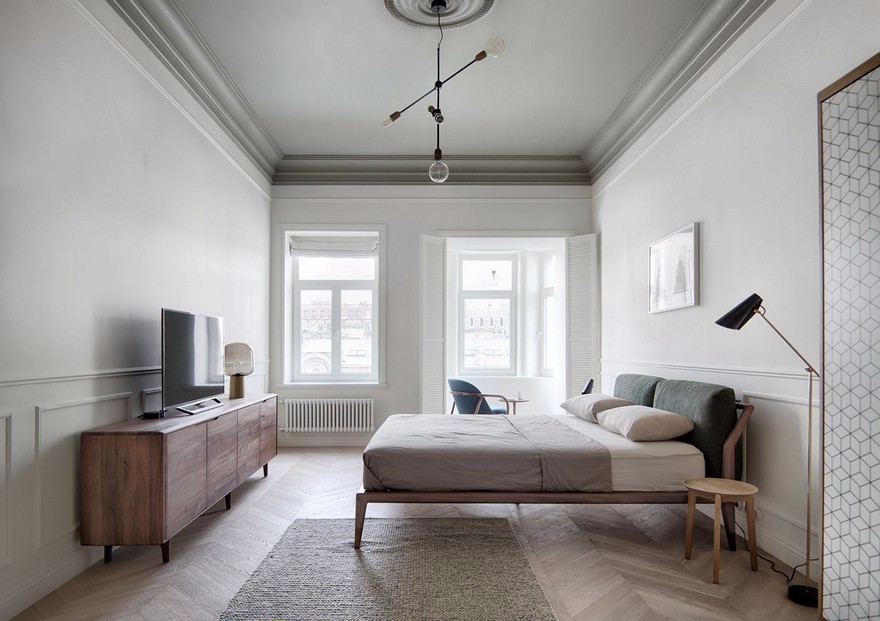Soong Lab松涛建筑设计 禧泉Joyous Spring疗愈中心 第三百四十二篇 _20250801
2025-08-01 20:26


生活
艺术
一处精神庇护所


我们创造的是一处精神庇护所,一定给予我们丰富感知体验的外部与内部空间。探寻一种不破坏自然并帮助我们与自然融为一体的生活方式,一类趋近于克己复礼的完美道德途径。
01
设计实景


Design reality
由 Soong Lab松涛建筑设计事务所主持完成的禧泉 Joyous Spring 疗愈中心,坐落于北京五环外,占地约 8200㎡。作为一次适应性再利用设计的实践,项目以“水”为媒介,通过对结构的改造、内部空间的重构,以及功能体系的引入,延续了原有闲置建筑的生命轨迹,并赋予其新的使用功能与空间意义——一个集汤泉、理疗、SPA、美食、度假住宿等于一体的综合性都市康养体验空间。
The Joyous Spring Wellness Center, designed by Soong Lab—founded and directed by architect Wang Songtao—is located just beyond Beijing’s Fifth Ring Road, with a site area of approximately 8,200 square meters. As a project of adaptive reuse, it is centered around water as a core element. Through structural adjustments, interior reconfiguration, and the addition of new programs, the design revitalizes an idle building, giving it renewed purpose and spatial significance. The space now functions as a holistic urban retreat—an immersive destination that integrates hot spring bathing, therapy, spa services, dining, and short-stay accommodations.
▼户外景观泳池望向交通景廊
Outdoor landscaped swimming pool looking towards the traffic view corridor


▼景观泡池区望向景观庭院
Landscaped soaking pool area looking out onto landscaped courtyard


▼景观庭院
landscaped courtyard


消失的屋顶,光的入口
Where the Roof Disappeared, Light Entered
设计以场地中央一处地下空间的屋顶(原建筑室内泳池区的玻璃双坡屋面)为切入点。拆除原屋顶,成为场地激活的起点。由此,建筑关系被重新定义,空间向上打开,与外界产生直接对话;同时引发了一系列功能与体验的重构:户外景观庭院、不同感受的室内温泉泡池、连接内外的交通景廊,以及可承载活动的户外泳池区。屋顶的“消失”不仅重塑了建筑的状态,也创造出一处嵌入地下的,承载着“自然与光”的容器。
The design begins with the removal of a roof at the center of the site, originally a glass double-pitched structure above an indoor swimming pool. This act of subtraction becomes the catalyst for reactivating the space. With the roof removed, the architecture opens upward and reconnects directly with the sky. The spatial relationships are redefined, giving rise to a new sequence of experiences: a sunken landscape courtyard, a series of indoor hot spring pools with varying atmospheres, a circulation corridor that links inside and out, and an outdoor pool zone designed for both relaxation and activity.
▼改造前后轴测
Before and after axonometric


▼嵌入地下的景观庭院
a sunken landscape courtyard




这片屋顶的拆除使空间被打开,天空光线洒落,曾经封闭的地下空间转化为下沉式户外景观庭院,成为引光入室的媒介。自然光穿透庭院景窗(新定义的室内外边界),层层渗入建筑内部,与水相遇、与环境融合,并与人的感知建立起持续的联系——几乎让人察觉不到,这里曾是一处封闭幽暗的地下空间。
The removal of the roof transforms the former subterranean interior into an open-air sunken courtyard. Natural light now pours in from above, allowing natural light to pour in from above. Light filters through newly defined garden windows—reimagined as thresholds between interior and exterior—and gradually extends deeper into the building, where it meets water, blends with the environment, and engages the human senses. It becomes almost imperceptible that this was once a closed, dim underground space.
▼下沉式户外景观庭院
an open-air sunken courtyard






以“水”为线索的感官叙事也由此展开,在光的引导下形成阶段递进的节奏——临近户外庭院,是阳光充沛的景观泡池,气氛轻盈;继续深入,光线渐趋柔和,构成一个围合感更强的“水院儿”,静谧而柔和;而在最深处,几近无光,设置干湿蒸与泡池,空间愈发内敛包容,引导人进入一个更为私密、沉浸的感官体验世界。
From here, a sensory journey unfolds, guided by light and organized around the theme of water. Near the courtyard, sunlight fills the landscape pools, creating a bright and uplifting atmosphere. Deeper inside, the light softens, enclosing a quieter water court that feels still and gentle. At the farthest end—where the light nearly disappears—dry and wet steam rooms and deeper soaking pools form a more intimate, inward-facing environment, guiding visitors into a private, immersive realm of physical and emotional restoration.
▼景观泡池
the landscape pools


自然地源与浴场文明的启发
Inspired by Natural Origins and Bathing Culture
自古以来,人们便以汤浴为身心疗愈之道,其历史亦是一部关于自然、身体与精神共鸣的文明长卷,有关其“疗愈作用”的记载遍及世界各地。例如中国唐代《本草拾遗》已系统记录温泉的药用价值,罗马帝国曾修建数个大型公共浴场,兼具清洁、治疗、社交功能。从缓解病痛的生存本能,到融合医学与交往的文明场域,汤泉的形式始终存在,并持续演化。
Since ancient times, hot spring bathing has been a path to physical and mental healing. Its history is, in many ways, a chronicle of the resonance between nature, the body, and the spirit. From Tang Dynasty texts like Compendium of Materia Medica, which recorded the medicinal value of hot springs, to the Roman Empire’s vast public bathhouses, which served purposes of hygiene, healing, and social gathering. From a primal instinct to relieve pain to a cultural setting that bridges medicine and interaction, the form of the bath has persisted and evolved over time.
▼水院泡池
the pools




▼整片水域在开放与围合之间展开
the water landscape unfolds between openness and enclosure






▼整片水域在开放与围合之间展开
the water landscape unfolds between openness and enclosure


设计团队在充分调研与场地勘察的基础上,将建筑的负一层设定为汤泉主体区域,建筑面积约6300 ㎡,回应了汤泉“源于地”的文化意涵。设计师借助原有“结构柱”和“建筑基台”之间的芯层深度,顺势构筑“池位”,使整个地下空间既具备舒适的层高,又无需对结构做过度干预,同时弱化了立柱对空间流线的割裂。随后,通过引入户外泳池、景观花园、连廊、阳光房等元素,使建筑上下层形成双水联动,内外之间亦自然贯通。
The design team positioned the hot spring program on the basement level, covering a gross floor area of approximately 6,300 square meters. This decision responds to the cultural notion of hot springs as “arising from the earth.” Using the natural depth between the structural columns and the building’s foundation platform, the pools were set in place without excessive structural intervention. This preserved comfortable ceiling heights while minimizing disruption to spatial flow. The addition of outdoor pools, garden courtyards, corridors, and sunlit rooms creates a dual-layered water system that connects above and below, inside and out.
▼汤泉主体区域
the hot spring program


▼形成水与水之间联动
a dual-layered water system




整片水域在开放与围合之间展开,包裹着数个水温与疗效各异的汤池。墙体、窗洞、台阶等建筑语言,共同营造出自然洞穴般的沉浸氛围,并融汇为有序的环形动线——既引导浴客按预设路径和空间节奏依次体验各处,也保留了自主探索的自由。
The water landscape unfolds between openness and enclosure, surrounding a series of thermal pools with different temperatures and therapeutic qualities. Architectural elements such as walls, apertures, and steps form a spatial rhythm that evokes a cave-like, immersive environment. Together, they shape an intuitive circular path—gently guiding guests through a curated sequence while allowing space for free exploration.
▼营造出自然洞穴般的沉浸氛围
form a spatial rhythm that evokes a cave-like




▼泡池区细节
pool detail




不同于当下多数新式汤泉的男女分浴逻辑,项目有意识地回归传统汤泉的治本之道,打造更为原始、自由的共浴机制,唤起人与人之间在同一空间中自然共处的状态。置身其中,宾客得以卸下外在的身份标签,以平等的姿态相遇,共享这片水域所带来的情绪与温度,同时,在感官的层层调动中,逐渐触及内在的自我。这种看似“老派”的设置,不仅是对功能模式的再思考,更是对古老社交形式与情感连接的当代表达。
In contrast to many modern spas that follow a strict gender-segregated model, this project consciously returns to a more primal, inclusive bathing tradition. It fosters a shared space where individuals can coexist naturally, leaving behind external identities and meeting as equals. In this state of emotional openness and sensory attunement, guests gradually reconnect with their inner selves. What may seem like an “old-fashioned” approach is, in fact, a contemporary reflection on communal intimacy, social rituals, and the emotional power of water.
▼药浴泡池
herbal bath




光合作用与情绪心理的映照
Photosynthesis and Emotional Reflection
光合作用是植物的生化过程,情绪则源于人们的大脑活动,二者看似无关,却在自然与心理之间存在深刻而间接的联动。光照、氧气与植被不仅维持生态平衡,也在潜移默化地中调节人的心理状态。项目中对“光”与“植物”的运用,正是对这种微妙关系的有意识回应。
Photosynthesis is a plant’s biochemical process, while emotions arise from the human brain. Though different, they share a subtle connection through nature’s influence on our psychology. Light, oxygen, and plants maintain ecological balance and quietly affect mental well-being. This project’s use of light and vegetation consciously responds to this link.
▼对“光”与“植物”的运用
use of light and vegetation


明与暗的节奏,自接待厅起便悄然铺陈,在空间中缓缓推进,成为了释放情绪与和情感转换的无形载体。侧窗、天光、幕墙、玻璃砖墙等建筑元素引入自然光线,通过采光强弱塑造各功能区的氛围基调,注入或静谧、或纯粹的张力,唤起沉浸式体验。
A rhythm of light and shadow begins at the reception, unfolding through the space as an unseen medium for emotional release. Windows, skylights, and glass elements bring natural light, shaping each area’s mood with varied brightness—from calm to dynamic—creating immersive experiences.
▼接待厅
the reception hall






▼通过采光强弱塑造各功能区的氛围基调
shaping each area’s mood with varied brightness




从明亮的地表向沉静地下的过渡过程中,光的表达跟随宾客的活动轨迹,转化为“面”、“线”、“点”的形式。渐暗的更衣区如同安静下来的前奏;汤泉区在盒式结构与暗环境中,以精巧的光束控制与围合设计,构建出流动的界面,引导身体放松与感官觉醒;而回到公共休闲区、咖啡与花园餐厅时,光线则再次攀升至明亮的高点。
As visitors move from bright surface levels to quiet underground spaces, light shifts into planes, lines, and points that guide their path. Dim locker rooms offer a calm prelude; the hot spring area uses focused light and enclosure to encourage relaxation and sensory awakening. Light brightens again in the lounge, café, and garden restaurant.
▼花园餐厅
garden restaurant






▼全日制餐厅
all-day restaurant




▼休息区
lounge


▼泡池走廊
corridor towards the spa pool




▼更鞋大堂
changing lobby


▼女宾更衣及淋浴区
Lady’s changing room


▼女宾更衣及淋浴区
Lady’s changing room




▼汗蒸区
steam area






植物则在光的牵引下,成为空间中另一重自然语言。植物设计师选用多样植物群落,从入口的室外景观延展至室内各区域。绿植不仅调和了建筑与人之间的尺度关系,也以其静默姿态与呼吸节奏,为室内注入鲜活的生命感,使人在知觉渐次被唤醒的过程中,悄然完成从外部世界回归内心的过渡。
Guided by light, plants serve as a second language of nature within the space. Selected greenery flows from the outdoor entrance into interiors, balancing scale and bringing life with their silent presence. This gradual sensory awakening helps guests transition from the outside world to inner calm.
▼植物成为空间中另一重自然语言
plants serve as a second language of nature




从秘境体验到深度放松
From Secret Sanctuary to Deep Relaxation
禧泉 Joyous Spring内整合了桑拿、按摩、中医理疗、美容SPA、局部护理等功能,同时引入氧舱、EVA生命光舱、熏蒸房、盐疗房等科技疗愈单元。在自然材质与设备协同作用下,构建出一个完整且可持续的康养体系。面对这样一个沉浸式的疗愈场域,设计策略聚焦于空间与身心关系的重构。通过尺度、路径、材质与氛围的协同,逐层展开体验的节奏,延伸其深度与时间性。
Joyous Spring combines saunas, massages, traditional Chinese therapies, SPA, and advanced healing tech like oxygen chambers and salt therapy. Natural materials and equipment work together to form a complete, sustainable wellness system. The design focuses on reconnecting space with body and mind through scale, flow, materials, and atmosphere.
▼汗蒸区
steam room








▼汗蒸区盐蒸房内部
Inside the Salt Steam Room in the Sweat Zone




为深化体验的丰富性,空间中嵌入多层级住宿单元:既有适于短时停留的简约客房,也设有可预约的大面积私密套间,使疗愈从数小时自然过渡至一日乃至数日,融入日常节奏,形成连续的修复状态。
To enrich the healing journey, multiple accommodation levels are embedded within the space: from simple rooms for short stays to large private suites available by appointment. This allows healing to naturally extend from hours to days, blending seamlessly into daily rhythms and supporting the continuous restoration.
▼客房区
Guest room










疗愈体验亦跟随材质的介入,与环境氛围的变化而被逐步唤醒。公共区域采用夯土墙体与原石材质,仿若置身岩洞之间,配合草本植物、盐块、中草药等天然材料的肌理与气息,编织出清新而沉静的自然氛围。自然肌理不仅在触觉与嗅觉层面包裹着人的感知,也心理层面构成了精神上的“围合”。
The therapeutic experience awakens gradually with the introduction of materials and shifting atmospheres. Public areas feature rammed earth walls and natural stone textures, evoking a cave-like setting. Herbal plants, salt blocks, and traditional medicinal materials add fresh, tranquil natural layers. These textures envelop the senses physically and mentally, creating a psychological sense of enclosure.
▼公共区域采用原石材质
Public areas feature natural stone textures






▼编织出清新而沉静的自然氛围
Weaving a fresh and calm natural atmosphere


▼接待大堂与更鞋大堂之间的旋转楼梯
Rotating staircase between the reception lobby and the shoe changing lobby


▼客房楼走廊通往酒吧
Guest House corridor leading to the bar


在这里,空间不再只是物理容器,而更像一个感知场域。它唤醒那些被日常遮蔽的感官知觉。人在其中,由表及里逐层过渡,仿若泛音浮现于沉静之下,不依靠外力,而是通过自我内调,完成一种内在秩序的回归。
Here, space becomes more than a physical container—it acts as a perceptual field. It reawakens senses often dulled by daily life. Visitors transition from surface to depth, like resonant overtones beneath stillness, achieving inner balance not through external force, but through gentle self-attunement.
▼夜景
Night view








▼一层平面图
I F plan


▼负一层平面图
Basement floor plan


▼温泉室内轴测图
Spa interior axonometric


02
创作团队
Creative team
项目名称|禧泉 Joyous Spring 疗愈中心
项目位置|中国北京市朝阳区北苑东路临2号
项目业主|禧园文化集团
项目类型|康养空间、适应性再利用建筑
设计单位|Soong Lab 松涛建筑设计事务所
主持设计师|王松涛
设计团队|张健、王晓雨、李帅、常梦雅、王爽、杨树军、赵广文、刘东、孟维晗、李旭、苏峻
景观设计|北京越川观赏景观设计咨询有限公司
景观主创|杨浩
照明设计|北京锦霖照明设计有限公司(唐志林、李青竹、李强)
项目摄影|金伟琦、陈光辉、FaLa Photos、吴昂
家具提供|两三亭、KUNDESIGN户外家居、素元、relife 远风
施工团队|江苏飞翼建设工程有限公司
现场深化设计|李帅、杨树军、王晓雨、飞翼工事组
建筑面积|13000 m²
设计周期|2021年06月-2023年05月(一期/二期)
施工周期|2021年10月-2024年12月(一期/二期)
Project Name|Joyous Spring Wellness Center
Location|Beiyuan East Road, Chaoyang District, Beijing, China
Client|Joyous Garden Cultural Group
Element|Wellness Architecture, Adaptive Reuse
Design Company|Soong Lab
Lead Designer|Wang Songtao
Design Team|Jane Zhang, Wang Xiaoyu, Li Shuai, Chang Mengya, Wang Shuang, Yang Shujun, Zhao Guangwen, Liu Dong, Meng Weihan, Li Xu, Su Jun
Landscape Design|YCGS Landscape Architecture Consulting Co., Ltd.
Lead Landscape Designer: Yang Hao
Lighting Design|Beijing JINL Lighting Design Co., Ltd (Jolin, Chinjoo, Mr. Lee)
Photography|Jin Weiqi, Guanghui Chen, FaLa Photos, Wu Ang
Furniture Brand|AtelierTing, KUNDESIGN, THRUDESIGN, relife
Construction|Jiangsu Feiyi Construction Engineering Co., Ltd.
On-site Design Development|Li Shuai, Yang Shujun, Wang Xiaoyu, Jiangsu Feiyi Construction Engineering Co., LTD
Building Area|13000 m²
Design Period|2021.06 – 2023.05 (Phase I - Phase II)
Construction Period|2021.10 – 2024.12 (Phase I - Phase II)
设计共壹体
Soong Lab 松涛建筑设计
我们创造的是一处精神庇护所,一定给予我们丰富感知体验的外部与内部空间。探寻一种不破坏自然并帮助我们与自然融为一体的生活方式,一类趋近于克己复礼的完美道德途径。
灵魂、心灵、文学,都在求知,求真,求实,而设计思想的出路是在知识中凝聚成长。设计共壹体应运而生,长于文化的土壤,乘风破浪,一路上探索好的内容,报道好的内容,创作好的内容,让好的内容成为自身进阶最舒适的滋养。欢迎大家关注我们!
服务合作:
DMEDIA2023@163.COM
投稿合作:
DMEDIA2023@163.COM


























